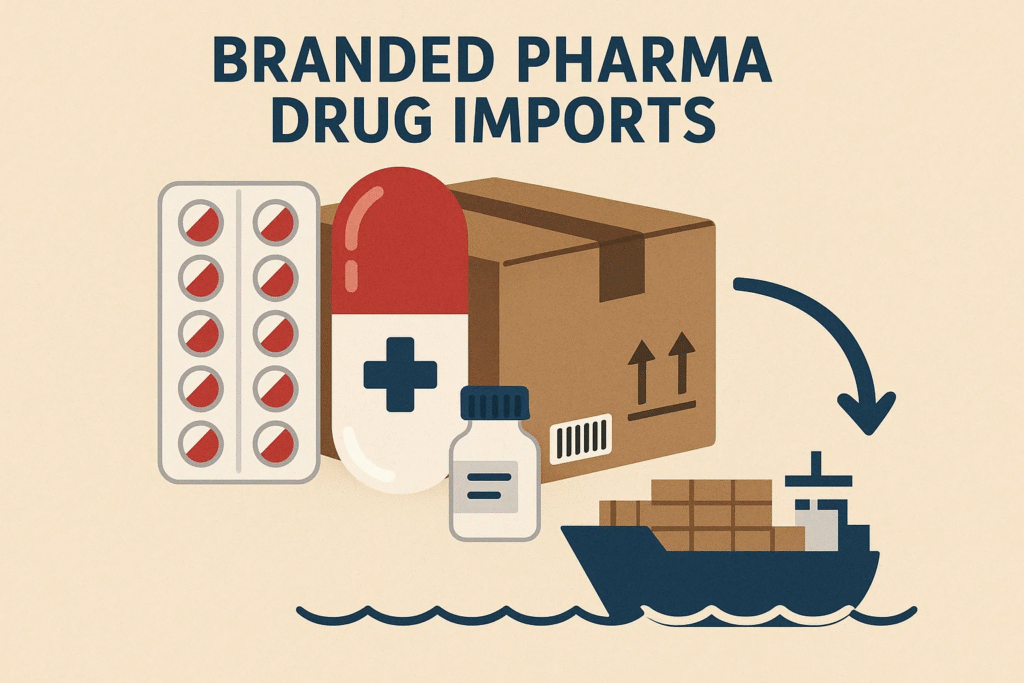Introduction
The recent announcement by former U.S. President Donald Trump regarding a 100% tariff on branded pharmaceutical drug imports has sparked a global debate. While the move is aimed at boosting domestic drug manufacturing in the United States, its ripple effects are already being analyzed in countries like India, one of the largest suppliers of generic medicines to the U.S. market.
Should India worry about this policy shift? Or does it present new opportunities for the Indian pharmaceutical industry? This comprehensive blog explores the impact of Trump’s 100% tariff on pharma imports, focusing on India’s drug exports, investor sentiment, global trade implications, and the future of healthcare supply chains.
Trump’s 100% Tariff on Pharma Imports: What It Means
In his announcement on Truth Social, Trump declared:
“I’m putting a 100% import tax on pharmaceutical drugs unless the companies are building plants right here in the United States. Breaking ground, under construction—that’s the deal. No exceptions.”
This means:
-
All imported branded and patented drugs face a 100% tariff if manufactured outside the U.S.
-
Companies can avoid tariffs only by building or shifting production facilities to U.S. soil.
-
The policy intends to create American jobs, reduce dependency on foreign pharma giants, and strengthen domestic supply chains.
But the big question for India is: Does this move threaten its pharmaceutical exports?
India’s Pharma Industry: A Global Leader
India is often called the “Pharmacy of the World.” With its strong generics sector, India supplies:
-
20% of global generic drug exports
-
40% of generic drugs consumed in the U.S.
-
Affordable life-saving medicines worldwide
India’s pharmaceutical industry is valued at over $50 billion, with exports crossing $25 billion annually. The U.S. is its single-largest market.
Why India May Not Be Immediately Affected
Experts suggest that Trump’s 100% tariff currently targets branded and patented drugs, not generics. Since India’s dominance lies in low-cost generics, the immediate threat is minimal.
Key points:
-
Indian companies like Sun Pharma, Dr. Reddy’s, Cipla, Lupin, Aurobindo focus primarily on generics.
-
Branded patented medicines are largely supplied by U.S. and European giants like Pfizer, Novartis, and Roche.
-
The Indian government has not expressed alarm but is monitoring developments.
Long-Term Concerns: What If Generics Are Included?
If tariffs are expanded to generic drugs, India could face:
-
Revenue Loss: Generics make up 70–80% of U.S. prescriptions. Any restriction could reduce India’s export revenue.
-
Investor Uncertainty: Pharma stocks in India may face volatility.
-
Trade Tensions: India and the U.S. already have friction in IT, textiles, and agricultural trade. Tariffs could worsen relations.
-
Healthcare Costs in the U.S.: Without Indian generics, U.S. drug prices may skyrocket, affecting millions of patients.
Table: India vs U.S. Pharma Snapshot
| Factor | India | United States |
|---|---|---|
| Pharma Industry Value | $50+ Billion | $600+ Billion |
| Key Strength | Generic Medicines | Patented/Branded Drugs |
| Share of Global Generics | 20% | <5% |
| Cost of Drug Production | 30–40% Lower | Much Higher |
| Dependence on Imports | Low | High (esp. APIs & generics) |
Global Reactions
-
U.S. Pharma Giants: Companies like Pfizer may support the policy to eliminate foreign competition.
-
European Union: Likely to raise concerns at WTO.
-
India: Watching carefully but avoiding confrontation.
-
Patients & Advocacy Groups: Fears of rising drug costs in the U.S. if competition is reduced.
Investor Sentiment in India
The Indian stock market often reacts sharply to U.S. policy changes. While the current tariff does not directly hit generics, investors remain cautious:
-
Pharma stocks may see short-term corrections.
-
Long-term growth outlook for generics remains strong.
-
Companies may explore U.S.-based manufacturing to avoid risks.
The Bigger Picture: Supply Chain Realignment
Trump’s 100% tariff reflects a larger trend of economic nationalism.
-
Similar policies are seen in semiconductors, EVs, and steel.
-
The U.S. wants to reduce dependence on China and India for critical sectors.
-
For pharma, it means encouraging “Made in USA” drugs, even if costs rise.
Should India Worry?
-
Short-term: No major impact, since generics are safe for now.
-
Medium-term: Indian companies may need to invest in U.S.-based plants to remain competitive.
-
Long-term: If generics are targeted, India must diversify markets (Africa, Latin America, Europe).
In summary, India should stay alert but not panic.
FAQs
Q1: What is Trump’s 100% tariff on pharma imports?
It’s a tax on branded and patented drugs imported into the U.S. unless manufactured domestically.
Q2: Does this affect Indian pharma exports?
Not immediately, since India exports mostly generics, not branded patented drugs.
Q3: Could generic drugs be included in the future?
Yes. If tariffs expand to generics, India could face revenue and market losses.
Q4: How would this impact U.S. patients?
Without Indian generics, U.S. drug costs could rise significantly, burdening patients.
Q5: What can Indian pharma companies do?
They can explore setting up manufacturing units in the U.S. or diversify exports to other global markets.
Q6: Will this policy survive long-term?
It depends on U.S. politics. Such tariffs often face legal and trade challenges at the WTO.
Conclusion
Trump’s 100% tariff on branded pharma drug imports is a bold move aimed at boosting U.S. manufacturing. For India, the impact is limited in the short run because its exports focus on low-cost generics.
However, the real worry is whether generics will be included in the future. If that happens, India’s pharma industry could face significant challenges. The best strategy for India is to stay diversified, invest in innovation, and prepare for policy shifts.
For now, India can watch the developments closely—but not lose sleep over them.


